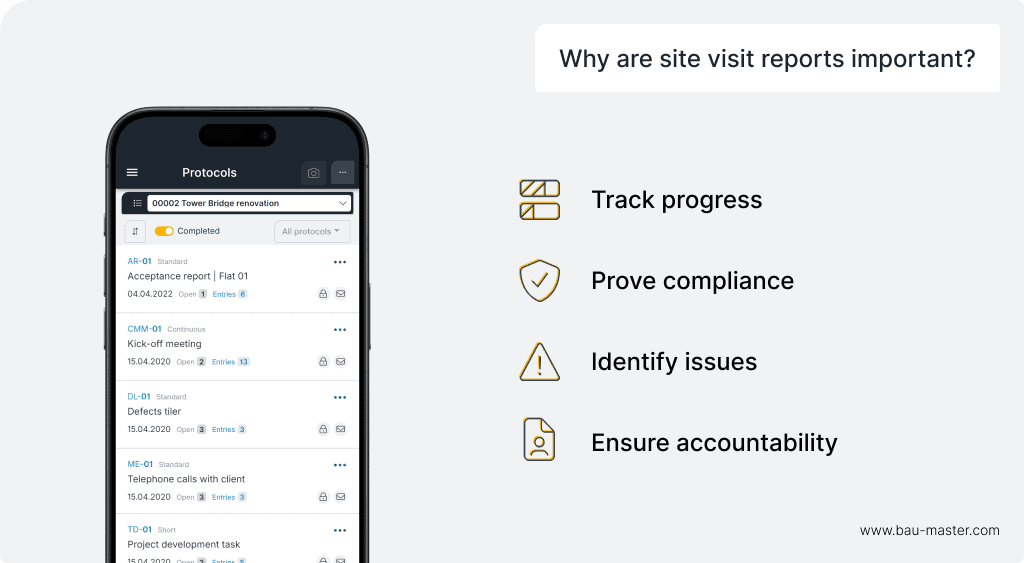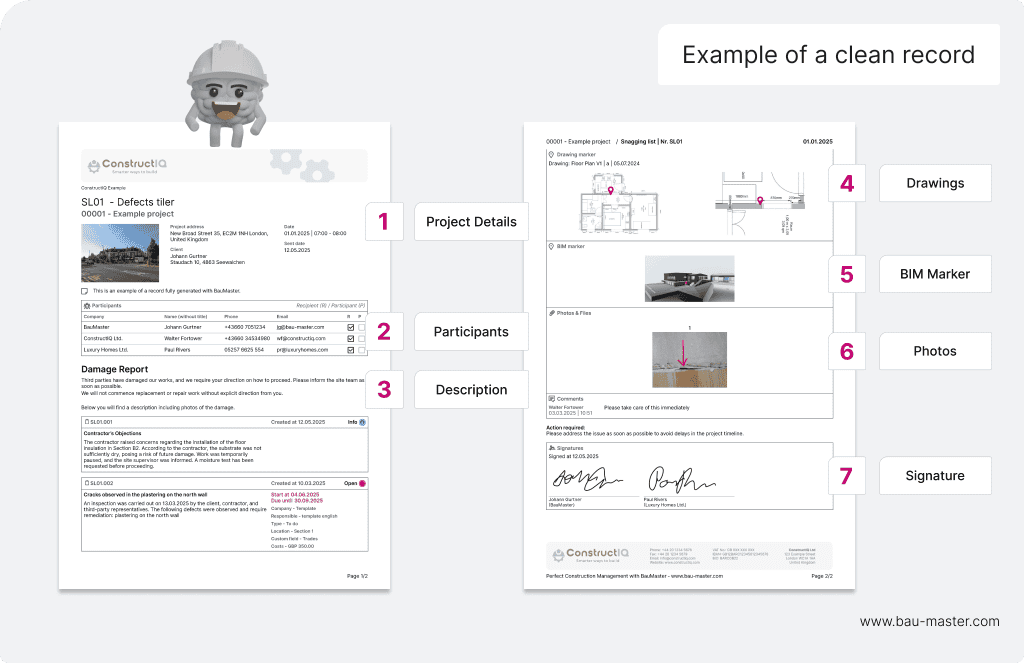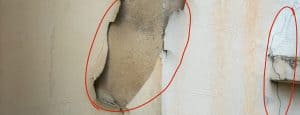Keeping track of progress, quality and safety on construction projects can be challenging. A site visit report helps bring clarity: it captures what’s happening on-site and turns observations into a structured, shareable record. This record provides transparency and accountability for all stakeholders – owners, project managers, site managers, architects, and contractors alike.
In this guide, you’ll learn what a site visit report is, how to write one, and why digital reporting is the smart long-term choice for construction professionals.
- What is a site visit report?
- Why are reports of every site visit important?
- Construction site visit report format: what to include
- How to write effective construction site visit reports
- Report templates vs. fully digital solutions
- Ready to streamline your construction site visit reports?
- FAQ – Frequently asked questions on site visit reports
Construction site visit reports at a glance
What is a site visit report? A formal document that records observations from a construction site visit: progress, quality, safety, issues, and next steps.
Why are reports of each site visit important? They provide transparency, track progress, prove compliance, and ensure issues are addressed before they become costly.
Site visit report format: most reports follow a clear structure – project details, purpose of the visit, site conditions and progress, issues, recommendations, photos, and sign-off.
Best practices for reporting site visits: write clearly and objectively, assign responsibilities, share reports promptly, back findings with photos, and use a consistent format.
Create well-structured digital construction reports with BauMaster:
Get to know our construction log software
What is a site visit report?
A site visit report is a formal document that records the observations made during an in-person inspection of a construction site. Its purpose is to provide a clear, factual snapshot of conditions at the time of your visit. A good report typically covers the following:
By documenting these points — often supported with photos or drawings — the report creates transparency and accountability among stakeholders. It ensures that everyone, from the client to the contractor, is aligned on the project’s current status.
The site visit report is one of several documents that track what happens on a construction site. Alongside it, teams often use:
▪️a site diary to capture daily activities,
▪️construction meeting minutes to record all meetings on-site,
▪️snag lists for construction defects,
▪️and more.
Together, they create a reliable record of the construction process.
Who prepares site visit reports?
Reports are usually prepared by project managers, site managers, architects, engineers, or client representatives – essentially, anyone qualified to assess progress and compliance. Depending on the project, site visit reports may be issued weekly, monthly, or at key milestones.
Common types of construction site visit reports
Why are reports of every site visit important?
In complex construction projects, miscommunication can quickly lead to delays, safety incidents or disputes. That’s why reports of every site visit are so valuable: they provide a reliable record that all parties can refer to. They help track progress, prove compliance with safety and design standards, and ensure issues are identified and addressed before they become costly problems.

Construction site visit report format: what to include
While every construction project has its own specifics, most reports follow a common structure. Using a consistent site visit report format ensures nothing important gets missed and makes them easier to read.
A sample site visit report format should include:
Below you’ll find a site visit report example with the key sections we just outlined:

This example shows how information can be structured clearly so that all stakeholders quickly see what needs attention. Use it as inspiration for your own reports – or take it a step further by adopting a digital tool like BauMaster, which generates professional reports with just a few clicks or finger taps.
How to write effective construction site visit reports
A site visit report is only valuable if it’s clear and detailed enough. Focusing on the right areas and avoiding common mistakes ensures your reports truly support the project.
1. Before the site visit
Good preparation ensures you don’t miss important details. Clarify the purpose of the visit: is it a progress check, a quality inspection or a safety audit? Review the latest drawings, the construction schedule and any outstanding issues from the last report. Plan your walkthrough by zones or trades, and make sure your tools are ready.
2. On site
Start with a quick briefing, then walk the site methodically. Record what you see objectively: note who was working, what was being done and where. Support your notes with photos, ideally showing both context and detail. If you identify an issue, write it down immediately, including its location and potential impact.
3. After the visit
A report is only valuable if it’s clear and timely. Make structured notes and highlight anything critical – e.g. delays with major impact. Attach photos and location markers, and make sure responsibilities and due dates are clearly assigned. Finally, circulate the document as soon as possible. Reports lose value if they sit in your draft folder for days.
Common mistakes for building construction site visit reports
Best practices for your site visit reports: write clearly, assign responsibilities, share reports promptly, back up findings with evidence, and use a consistent format. This way your reports will be both professional and effective.
Report templates vs. fully digital solutions
Using a Word or PDF site visit report template is often the easiest way to start. It gives you structure and ensures the most important sections are covered. But manual templates also come with limitations. They …
A digital solution like BauMaster removes these pain points. With a mobile construction documentation software, you can …
Ready to streamline your construction site visit reports?
In short: while templates for your site visit reports are a good first step, digital reporting makes the process faster, more reliable and far more collaborative – helping construction teams spend less time on paperwork and more time moving the project forward.
That’s precisely what BauMaster delivers. Instead of spending hours formatting documents after every site visit, you generate professional reports in minutes – and make them actionable: issues can be turned into tasks with owners and deadlines, and the traffic-light system shows at a glance whether they are open, in progress, or resolved.
This gives you more time for actually managing the site, and results in a higher-quality documentation that clients, colleagues, and contractors actually want to read. Try BauMaster today and experience how digital documentation improves your construction projects:
FAQ – Frequently asked questions on site visit reports
What is the aim of a site visit?
The aim of a site visit is to observe progress, check quality and safety, and identify any issues that need attention. It gives stakeholders a clear, first-hand view of the project’s current status.
What is the purpose of a site visit report?
A site visit report documents the findings from a building site visit in a structured way. It provides transparency, ensures accountability, and creates a record that can be shared with all stakeholders for decision-making and follow-up.
How do I write a construction site report?
Start by preparing before the visit, reviewing drawings and previous reports. On site, record observations objectively and support them with photos. After the visit, structure your report with project details, progress, issues, actions, and sign-off — and circulate it promptly.
What is included in a site report?
Most site reports include project and visit details, purpose of the visit, work progress, site conditions, identified issues, recommended actions, and supporting evidence like photos or test results. A conclusion and sign-off section completes the report.










